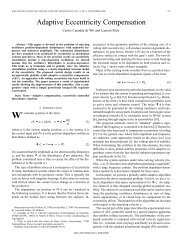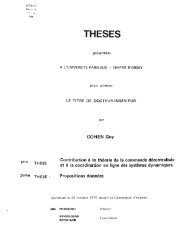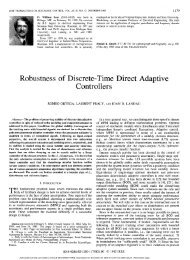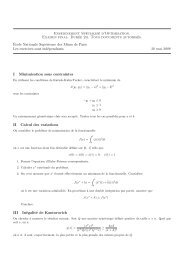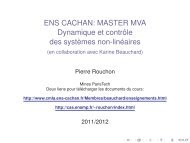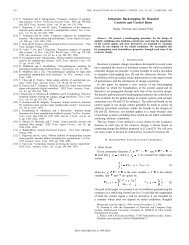Copyright © by SIAM. Unauthorized reproduction of this article is ...
Copyright © by SIAM. Unauthorized reproduction of this article is ...
Copyright © by SIAM. Unauthorized reproduction of this article is ...
Create successful ePaper yourself
Turn your PDF publications into a flip-book with our unique Google optimized e-Paper software.
1816 V. ANDRIEU, L. PRALY, AND A. ASTOLFI• Given r in (R + \{0}) n , S r = {x ∈ R n ||x| r = 1} <strong>is</strong> the unity homogeneoussphere. Note that each x in R n can be decomposed in polar coordinates; i.e.,there ex<strong>is</strong>t λ in R + and θ in S r sat<strong>is</strong>fying(1.7) x = λ r ⋄ θ with{ λ = |x|r(,) r1θ =|x| r⋄ x.2. Homogeneous approximation.2.1. Definitions. The use <strong>of</strong> homogeneous approximations has a long h<strong>is</strong>toryin the study <strong>of</strong> stability <strong>of</strong> an equilibrium. It can be traced back to the Lyapunovfirst order approximation theorem and has been pursued <strong>by</strong> many authors; see, forexample, Massera [16], Hahn [8], Hermes [9], and Rosier [29]. Similarly, <strong>th<strong>is</strong></strong> techniquehas been used to investigate the behavior <strong>of</strong> the solutions <strong>of</strong> dynamical systems atinfinity; see, for instance, Lefschetz in [14, Chapter IX.5] and Orsi, Praly, and Mareelsin [20]. In <strong>th<strong>is</strong></strong> section, we recall the definitions <strong>of</strong> homogeneous approximation at theorigin and at infinity and restate and/or complete some related results.Definition 2.1 (homogeneity in the 0-limit).• A function φ : R n → R <strong>is</strong> said to be homogeneous in the 0-limit with associatedtriple (r 0 ,d 0 ,φ 0 ), where r 0 in (R + \{0}) n <strong>is</strong> the weight, d 0 in R + thedegree, and φ 0 : R n → R the approximating function, if φ <strong>is</strong> continuous, φ 0<strong>is</strong> continuous and not identically zero, and, for each compact set C in R n \{0}and each ε> 0, there ex<strong>is</strong>ts λ 0 such thatmaxφ(λ r0 ⋄ x)x ∈ C∣ λ d0− φ 0 (x)∣ ≤ ε ∀ λ ∈ (0,λ 0] .• A vector field f = ∑ ni=1 f i ∂∂x i<strong>is</strong> said to be homogeneous in the 0-limit withassociated triple (r 0 , d 0 ,f 0 ), where r 0 in (R + \{0}) n <strong>is</strong> the weight, d 0 in R<strong>is</strong> the degree, and f 0 = ∑ ni=1 f 0,i ∂∂x i<strong>is</strong> the approximating vector field, if, foreach i in {1,...,n}, d 0 + r 0,i ≥ 0 and the function f i <strong>is</strong> homogeneous in the0-limit with associated triple (r 0 , d 0 + r 0,i ,f 0,i ).Th<strong>is</strong> notion <strong>of</strong> local approximation <strong>of</strong> a function or <strong>of</strong> a vector field can be foundin [9, 29, 2, 10].Example 2.2. The function δ 2 : R → R introduced in the illustrative system (1.1)<strong>is</strong> homogeneous in the 0-limit with associated triple (r 0 ,d 0 ,δ 2,0 ) = (1, q, c 0 x q 2 ). Furthermore,if q




